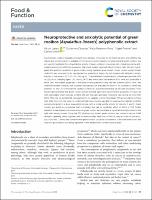Por favor, use este identificador para citar o enlazar este ítem:
https://repositorio.usj.es/handle/123456789/1053
| Título : | Neuroprotective and anxiolytic potential of green rooibos (Aspalathus linearis) polyphenolic extract |
| Autor: | Casedas, Guillermo


López Ramos, Víctor 

Smith, Carine 

(Petersen) Ross, Kelly 
Powrie, Yigael 
|
| Fecha de publicación: | 26-nov-2021 |
| Citación : | Food Funct., 2022,13, 91-101 |
| Resumen : | South African rooibos (Aspalathus linearis) tea is globally consumed for its health benefits and caffeine free nature, but no information is available on the neuroprotective capacity of (unfermented) green rooibos. Our aim was to investigate the cytoprotective activity of green rooibos in neuronal cells, including probing antioxidant and enzyme inhibitory properties that could explain observed effects in these cells. We also investigated the anxiolytic potential of green rooibos using zebrafish larval models. Green rooibos extract (Green oxithin™) was assessed for its neuroprotective potential in Neuro-2a cells treated with different concentrations of the extract (12.5–25–50–100 μg mL−1) and different concentrations of hydrogen peroxide (250 or 125 μM) as oxidizing agent. Cell viability (MTT) and redox status (intracellular ROS) were also quantified in these cells. Antioxidant properties of the extract were quantified using cell-free systems (DPPH, ORAC and xanthine/xanthine oxidase), and potential neuroprotection evaluated in terms of its potential to inhibit key enzymes of the CNS (monoamine oxidase A (MOA-A), acetylcholinesterase (AChE) and tyrosinase (TYR)). Results demonstrated that green rooibos extract exerted significant cytoprotective properties in Neuro-2a cells, particularly when exposed to lethal 250 μM hydrogen peroxide, increasing cell survival by more than 100%. This may be ascribed (at least partially) to its capacity to limit intracellular ROS accumulation in these cells. Data from cell-free systems confirmed that green rooibos was able to scavenge free radicals (synthetic and physiological) in a dose dependent manner with a similar profile activity to vitamins C and E. Green rooibos also acted as a moderate MAO-A inhibitor, but had no significant effect on AChE or TYR. Finally, zebrafish larvae treated with lower doses of green rooibos demonstrated a significant anxiolytic effect in the light–dark anxiety model. Using the PTZ excitotoxicity model, green rooibos was shown to rescue GABA receptor signalling, which together with its demonstrated inhibition of MAO-A, may account for the anxiolytic outcome. Current data confirms that green rooibos could be considered a “functional brain food” and may be a good option as starting ingredient in the development of new nutraceuticals. |
| URI : | https://repositorio.usj.es/handle/123456789/1053 |
| ISSN : | 2042-6496 |
| Aparece en las colecciones: | Artículos de revistas |
Ficheros en este ítem:
| Fichero | Descripción | Tamaño | Formato | |
|---|---|---|---|---|
| Neuroprotective and anxiolytic potential of green rooibos.pdf | 2,58 MB | Adobe PDF |  Visualizar/Abrir |
Este ítem está sujeto a una licencia Creative Commons Licencia Creative Commons

